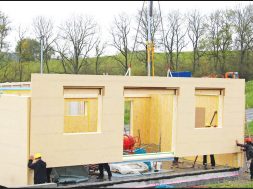The Creative Essentials
Architecture and aesthetics are important elements of the built environment we are a part of. Ace Update speaks to three different professionals to understand their point of view.
The genesis of architecture indicates the evolution of the human mind. And in the broader sense, it represents the human civilization itself. It also serves as an element which allows modern day experts to interpret the societies and nations as it existed in the times gone by. In a similar vein the development of architecture and design in present times says a lot about where the story is headed.
Architects in this sense become important elements of the built environment we all are a part of. This is an environment where the narrative of form and function blends with aesthetics to please us, appease us and surprise us.
So What Is Architecture After All?
Rooshad Shroff, Founder Principal, Rooshad Shroff Architecture and Design believes “Architecture is more than an indicator of progress; it reflects the mood and sentiments at a given time. It is therefore imperative for an individual to study the history of architecture in order to get a better understanding of the socio-economic fabric of a given place at a given time. A response to its prevailing context – be it context of material, technology, political or economical.Without architecture we would not be able to trace back history.”
Augmenting Rooshad’s opinion Abhigyan Neogi, Founder Principal of Chromed Design Studio points out that architecture in true sense is a response to the way humans have evolved as species. He says “As we evolve, our sensibility towards the environment keeps altering constantly. In the beginning, barbarians felt a primitive need to make huts, whereas, currently designers tend to fabricate extremely complicated structures. How one responds to an immediate environment has a direct connection with how they react to it in architecture where they respond to an external stimulus according to their own comfort level. As the civilisation is advancing, the personage seeks a snug habitat, outlining a direct relationship between evolution and stimulus. Similarly, as resources are getting depleted persistently, the designers have started practising sustainable development. Hence, architecture gravitates to be a reflection of response to evolution.”
Sapna Khakharia Gohil, Director – Design, ANJ Group believes that we as humans utilise architecture as a syntax of our human expression and aspiration. “Architecture,” Sapna says “has evolved in its scope, aesthetic and application over millennia – morphing in tandem with our evolution as a species. It has constantly mirrored the existential patterns of the nomadic man, through to our cognitive peaking as a species. A timeline when the concept of shelter took on a more static yet refined form. From here onwards it has gone on to reflect the birth of cultures, governed both by mythology and location. Thus architecture has always served as a barometer for both human expression and aspiration.”
The Role of Aesthetics
Aesthetics is an important part of life itself. So the infusion of aesthetics in the universe of architecture is a natural consequence. We as humans have a tendency to fall in love with living and commercial spaces which are well designed. Not to mention well designed products.
“Though one can claim aesthetics is something subjective, it helps maintain a balance within a given space and add a good dose of visual appeal,” says Rooshad “Symmetry and proportions are key parameters which help me divide a given space, or layer it up via material play. That symmetry then translates to a visual vocabulary with the induction of colour and the right kind of interior accessories.”
Abhigyan believes aesthetics enhances the design narrative of the function it serves “There are three ways to make a project aesthetically appealing,” says Neogi “one is rudimentary, i.e., to follow a standard set of tried and tested norms of conventional design techniques. Another is to outline a built environment with symmetry, trending colours, apt lighting and fundamental decor elements that make the usual aesthetics work. Last but not least is destruction, where we create an offbeat aura with a disruptive pattern of unanticipated aesthetics. The idea always is to create a design narrative where material & interior accessories serve as tools to narrate the story and enhance the narrative irrespective of the functional regime.”
The function of aesthetics goes beyond enhancing narratives. Aesthetics is often seen as a dynamic entity which evokes an emotion and connects with our varied moods and thoughts. “Aesthetics are a nuanced play between elements both tangible and intangible, serving to dictate sensorial and spatial experience,” says Sapna “this experience must be unique to every project – designed stimulation to invigorate the particular spectrum of emotions a space is intended to conjure. The interactions between the tangible – defined by mass, volume, colour, texture, and elements by way of decor, interact uniquely with what is transient – the sun, the winds, rain, light and shadow. Materials and interior accessories act as receptacles to harness what is beautiful about the transient that we permit into our space – manipulating the latter to create mood and ambience.”
Branded Accessories vs Customised Design
The role play of interior accessories in the universe of architecture and design is massive. Contemporary brands have capitalised on this opportunity and improved the reach of good design. In retaliation designers too have invoked the magic of customisation to garner their individual clientele.
Gohil points out “There are a number of both established and upcoming brands in the industry, catering to every aspect of a built project, constantly innovating and churning out exciting new products. Personally, we believe many of these are at par, and application of course governed by the practical constraints of a project, ranging from timelines, scope and cost. This being said, as a designer and as a part of a creative agency our prime focus lies in offering customized solutions, we try to give free reign to our creativity and customize whenever innovation is practically possible.”
Shroff also furthers the idea of customised design “We love designing everything! Clients most often come to us as we offer a bespoke service customising to a great degree in every project we execute.” Neogi too is quick to add “We too believe in a bespoke solution for every project irrespective of the brand. The accessory should fit in the edifice.”
Brands will continue to thrive but customisation will perhaps continue to define the future of architecture and design.
Architecture is more than an indicator of progress; it reflects the mood and sentiments at a given time.
Rooshad Shroff, Founder Principal, Rooshad Shroff Architecture and Design
How one responds to an immediate environment has a direct connection with how they react to it in architecture where they respond to an external stimulus according to their own comfort level.
Abhigyan Neogi, Founder Principal of Chromed Design Studio
Architecture has evolved in its scope, aesthetic and application over millennia – morphing in tandem with our evolution as a species.
Sapna Khakharia Gohil, Director – Design, ANJ Group
5
Cookie Consent
We use cookies to personalize your experience. By continuing to visit this website you agree to our Terms & Conditions, Privacy Policy and Cookie Policy.









